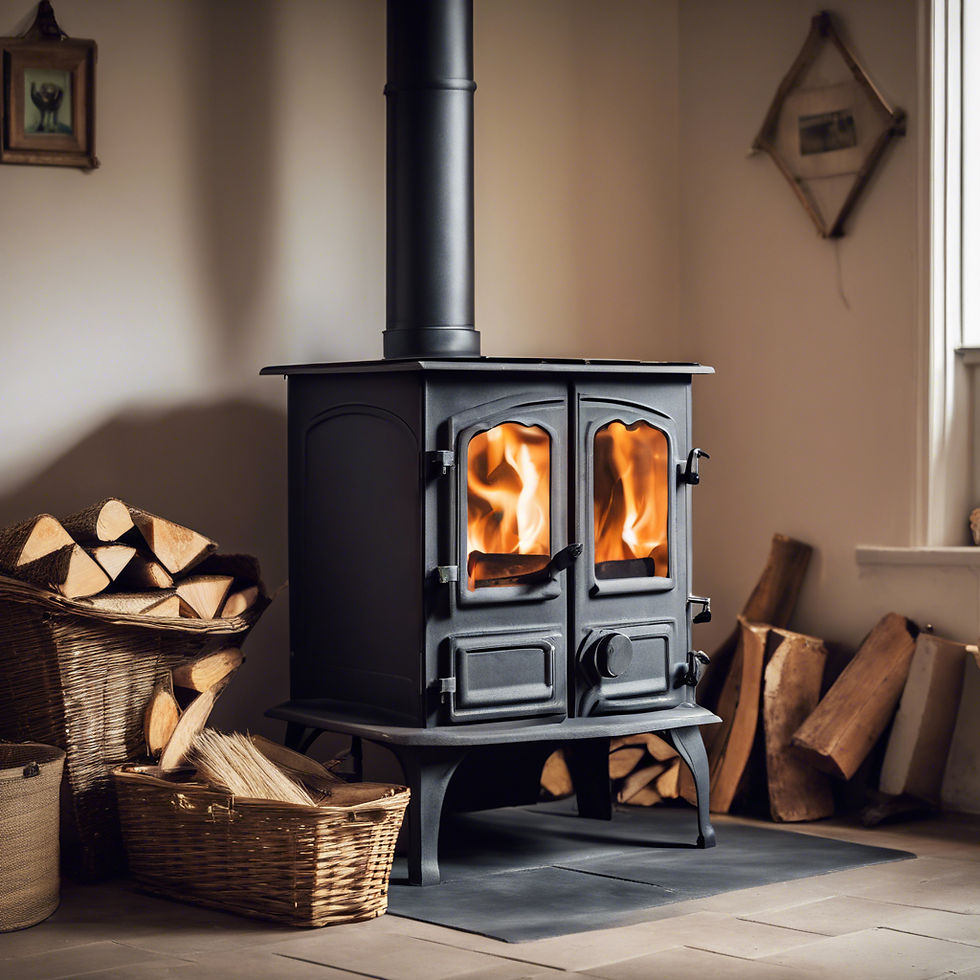Mastering Your Log Burner or Multi-Fuel Stoves Air Controls: A Guide by Safe-Sweep Chimney Sweep 🎩🔥
- safesweepwirral
- Sep 29, 2024
- 4 min read

As the colder months approach, many of us in Wirral, Chester, and Ellesmere Port turn to our trusty log burners and multi-fuel stoves to keep our homes warm and cozy.
However, to get the most out of your stove, it’s essential to understand how to use the air controls effectively. Whether you’re burning wood or coal, proper use of these controls can enhance efficiency, reduce emissions, and ensure a safe and pleasant burning experience.
Understanding Your Stove’s Air Controls
Most log burners and multi-fuel stoves come equipped with two or three types of air controls:
Here is a picture of a Saltfire Peanut Stove labelled with the air controls mentioned below..all stoves are different so please refer to your stove manual to identify the air controls for your own model of stove

• Primary Air Control: This is usually located at the bottom of the stove and supplies air to the base of the fire. It’s crucial for getting the fire started and is particularly important when burning coal.
• Secondary Air Control: Found at the top or front of the stove, this control helps to burn off gases released by the fuel, improving efficiency and reducing smoke. It’s especially useful when burning wood.
• Tertiary Air Control: Some advanced stoves have a tertiary air supply, which introduces air into the firebox to ensure complete combustion of gases, further enhancing efficiency and reducing emissions.
Best Practices for Burning Wood
When burning wood, follow these steps to make the most of your stoves air controls:

• Start with the Primary Air Control: Open the primary air control fully to allow maximum airflow to the base of the fire. This helps the fire catch quickly.
• Adjust the Secondary Air Control: Once the fire is established, gradually close the primary air control and use the secondary air control to manage the burn rate. Wood burns best with air coming from above, so the secondary air control is key to a sucessful burn.
• Maintain the Fire: Keep an eye on the fire and adjust the secondary air control as needed to maintain a steady burn. Too much air can cause the wood to burn too quickly, while too little can smother the fire.
A stove pipe thermometer is a great addition to help you gauge the burn rate of your wood and gives you a visual indicator that allows you to adjust the air controls at the right time.
Best Practices for Burning Coal

Coal requires a slightly different approach:
• Maximise Primary Airflow: Open the primary air control fully to supply ample air to the base of the fire. Coal needs a strong airflow from below to ignite and burn efficiently. It's recommended to have a clear grate when starting a fire with coal as airflow from below is paramount to a successful burn with coal.
• Secondary Air Control: Once the coal is burning well, you can adjust the secondary air control to an almost closed position as the primary air control will remain the main focus for maintaining a coal fire.
• Monitor and Adjust: Keep the primary air control open enough to maintain a bright, hot fire. Adjust as necessary to ensure the coal burns steadily without producing excessive smoke.
The same principle applies about a stove pipe thermometer, its a useful bit of kit.
Reducing Emissions and Complying with Smoke Control Orders
Proper air control not only improves efficiency but also plays a crucial role in reducing emissions. This is particularly important for residents of Wirral, Chester, and Ellesmere Port, where smoke control orders are in place to maintain air quality.

• Efficient Combustion: By using the air controls correctly, you ensure that the fuel burns more completely, producing less smoke and fewer harmful particulates. This helps to keep emissions within permitted limits and contributes to cleaner air in our community.
• Compliance with Regulations: Adhering to smoke control orders means using approved fuels and operating your stove efficiently. Proper air control is a key part of this, as it minimises the release of pollutants.
• Environmental Responsibility: Reducing emissions is not just about compliance; it’s about being a responsible member of your community. By managing your stove’s air controls effectively, you contribute to a healthier environment for everyone.
Why Choose NVQ Qualified Chimney Sweeps?

Regular maintenance of your stove and chimney is crucial for safety and efficiency. NVQ qualified chimney sweeps, like Safe-Sweep Chimney Sweep, have the training and expertise to ensure your chimney is clean and your stove is operating at its best efficiency.
They can also provide valuable advice on using your stove’s air controls and maintaining optimal performance.
Conclusion
By mastering the use of your stove’s air controls, you can enjoy a warmer, more efficient home this winter. Whether you’re burning wood or coal, understanding how to adjust the primary, secondary, and tertiary air controls will make a significant difference to your burning experience.
Remember, for the best results and peace of mind, trust the NVQ qualified professionals at Safe-Sweep Chimney Sweep to keep your chimney in top condition.
For more tips and professional chimney services, contact Safe-Sweep Chimney Sweep TODAY.
Our NVQ qualified experts are here to help you make the most of your log burner or multi-fuel stove.






Comments